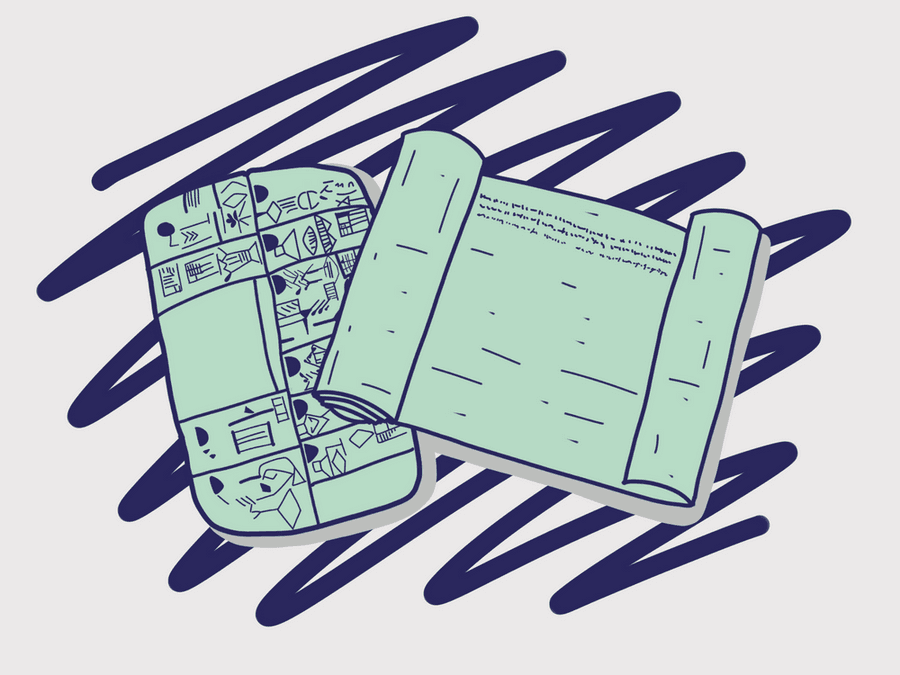Explore the World's Best Ideas
Join today and uncover 100+ curated journeys from 50+ topics. Unlock access to our mobile app with extensive features.
Clay tablets and papyrus scrolls
- Long before the use of paper, the Stimarians - people of Mesopotamia who lived around 3500-3000 B.C. - invented the Cuneiform writing system. It consisted of pictographs and phonograms that was etched on clay tablets. This method of writing was around for 2000 years.
- Papyrus Scroll dates from around 2400 B.C. They were made from the stem of the Papyrus plant and were about 10 - 40 metres long. Ancient Egyptians used reeds or bird feathers to write on the scrolls.
65
936 reads
Codex and paper inventions
- Codex is closer to modern books. The pages were made from folded leaves or parchments (animal skins) and bound together on one side, one after another. The earliest surviving codex dates back to the 4th century and is the greek biblical manuscript known as Codex Sinaiticus.
- Paper was invented by Cai Lun, an official of the Chinese Imperial court of Eastern Han. He used tree bark, rags hemp, and old fish nets to make paper. Paper started to be used in China, then spread around the world. Illustrated handwritten manuscripts were seen between 400-600 A.D.
55
225 reads
The first printed book
- Block printing probably originated in China. The letter of Chinese alphabets were carved in mirror writing on large wooden blocks. The ink would be applied to the entire block, and then paper was pressed against the block. The oldest surviving printed book is the Buddhist text, Diamond Sutra and dates to 868 A.D.
- Movable type was invented around 990-1051 A.D. by Bi Sheng of China. He carved single letters on small pieces of clay or wood instead of carving the whole book on a single block. The blocks could be rearranged and reused.
53
196 reads
A revolution to printing and writing
- In the 1440s, Johannes Gutenberg started to experiment with movable types. He made a metal movable type system of casting letters with screw press and hand mould. The machine was semi-mechanic but was very effective.
- The first complete book printed on the movable type was the Gutenberg Bible in 1455. 180 copies were created - 45 were printed on vellum (fine parchment) and 135 on paper.
- Gutenberg's invention led to a revolution in printing all over Europe. By the late 15th century, 20 million books were published as well as newspapers, magazines, and other media.
52
156 reads
Digitisation and digitalisation
The invention of the computer, microprocessor, and the internet has created a major digital transformation to books. E-books (electronic books) have become common.
However, nothing can change the fact that a book in any form - physical books, e-books or audiobooks, remains a pleasure.
48
193 reads
IDEAS CURATED BY
Big Bertie's ideas are part of this journey:
Learn more about books with this collection
How to challenge assumptions
How to generate new ideas
How to break out of traditional thinking patterns
Related collections
Similar ideas
9 ideas
The Evolution of Visual Effects From 1878 til Today
illustratedfiction.com
5 ideas
History of Fashion Week
fashionweekonline.com
4 ideas
Can a Vision Board Really Affect Your Future?
science.howstuffworks.com
Read & Learn
20x Faster
without
deepstash
with
deepstash
with
deepstash
Personalized microlearning
—
100+ Learning Journeys
—
Access to 200,000+ ideas
—
Access to the mobile app
—
Unlimited idea saving
—
—
Unlimited history
—
—
Unlimited listening to ideas
—
—
Downloading & offline access
—
—
Supercharge your mind with one idea per day
Enter your email and spend 1 minute every day to learn something new.
I agree to receive email updates

